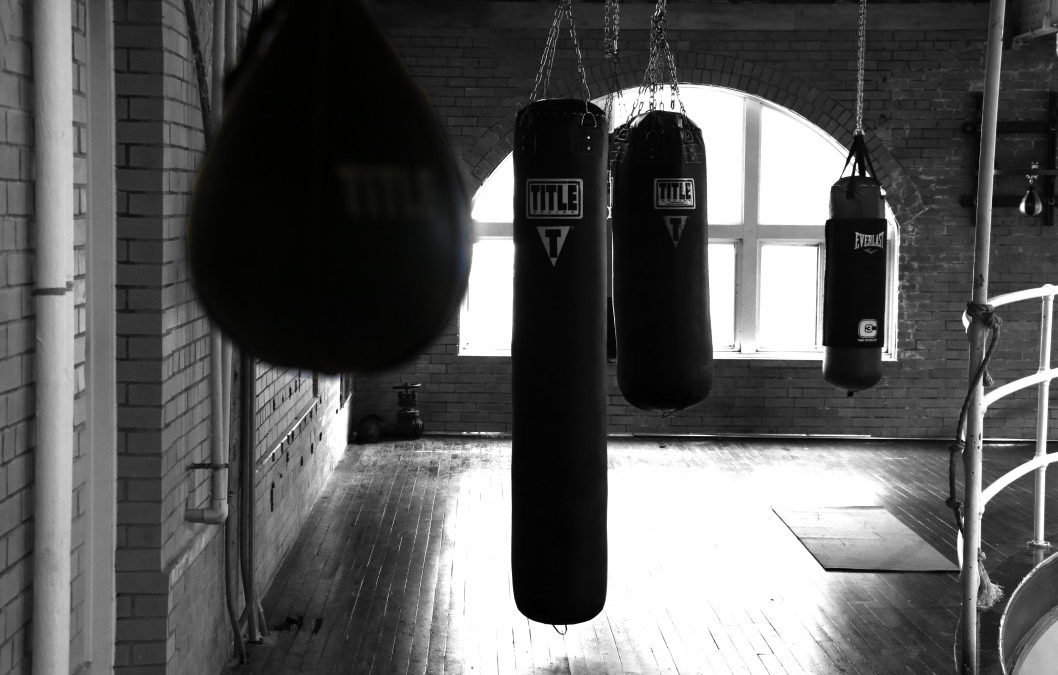Buying a punching bag is an investment and commitment. Now you are going to have this human sized thing hanging around your house reminding you to exercise. But punching bags are the one of the few things that you can punch as hard as you possibly can and nobody really cares. People actually encourage it!
There are lots of kinds of bags but these are the most common ones:
- A heavy bag is the big, person sized bag.
- A speed bag is the little air-filled bag hanging from the center of a platform. These are meant for hand speed, hand-eye coordination and rhythm training. It is the one that goes, “Bopity-bopity-bopity-bopity…”
- Double end bags are small round bags that are attached to the ground and ceiling by a bungee cord. They are for accuracy, speed and timing training… and are really frustrating.
Most people get a heavy bag. It is the most versatile and easiest to use.

Heavy Bags
There are three main kinds of heavy bags: Hanging, free-standing and inflatable.
- Hanging bags hang from the ceiling or a rack.
- Free-standing bags sit on the floor.
- Inflatable punching bags are fun but they don’t take a lot of abuse and one really hard punch and they either fall down or pop.
.png/:/cr=t:0%25,l:0%25,w:100%25,h:100%25/rs=w:1280/:/rs=w:1280)
There are also a lot of shapes of heavy bags:
- Traditional or Straight– The typical cylinder stuffed with stuff (usually shredded fabric) with a weighted bottom for stability.
- Muay Thai bags or Banana Bags are for training kicks and knee strikes for kick boxing, muay thai and MMA. They are longer (about 6’ long) and thinner.
- Round or teardrop shapes are smaller so they are good to work on accuracy and body punches. They are also called “wrecking balls” or Maize bags. They swing around a lot more so this makes them good for head and foot movement training.
- Upper Cut Bags look like an upside down beer bottle. The angel between the two diameters allows you to throw better uppercuts and body shots but the normal width on top allows straight punches.
- The double end heavy bag looks like the torso of a1950s pinup model. The benefit of this is it allows you to punch at angles that mimic the shape of a human body… if you are planning to fight Ava Gardner.
- Body Opponent Bag (BOB) – The punching bag that looks like an angry guy with no arms or legs. Fun but a little strange.
.png/:/cr=t:0%25,l:0%25,w:100%25,h:100%25/rs=w:1280/:/rs=w:1280)
The traditional straight bag is the most common.
For a Heavy Bag…
- You want to be able to move at least 180 degrees around your bag while you work out. This will enable you to keep your feet moving so you don’t just “plant and pound”. Perfectly, you can get all the way around it but that takes up a lot of room.
- 100 lbs. is the standard weight for a bag but that big is not necessary. Some people recommend a bag that is half of your body weight but no so light that it flails around too easily. I am happy with a 75 pound bag. You are not looking to pound on it really hard. You want fast and accurate; think “ZAP” not “baaaaammm”.
- Mui Tai and kick boxing bags are thinner and about six feet tall. You don’t need this big of a bag unless you plan on doing kicks on it.
- Heavy bags have various outer coverings; leather, vinyl, canvas, the skin of your enemies, etc.
- Leather is not a big advantage unless you are giving it A LOT of use. Leather can also have a strong smell.
- I like vinyl because it is cheap, I can draw on it, put tape on it for targets and just clean it with a windex.
- Make sure your bag is tall enough so you can punch at face height. You want to be reaching straight out from your face to theirs. Not down.
HANGING BAGS
- Most hanging punching bags are packed full of shredded fabric or foam with sand bags at the bottom to weigh it down. Some of them have a foam core or a roll of carpet in the middle to hold the form. Some have a water filled core. Some have “memory foam”.
- Hanging bags can be space hogs. Once they are up, there are staying there.
- Hanging bags have a more solid feel because you are hitting it closer to its center of gravity.
- Before you buy a hanging bag, make sure that you can hang it high enough where you work out so you can punch it at your face height. Face height should be about 1/4 to a 1/3 down from the top of the bag so you don’t risk hitting the chains or mounts and you are hitting closer to its “sweet spot”. If you hit it at or near the sweet spot the bag does not flail or jostle around. Too close to the top and the bag flops like a fish. Too close to the bottom and you hit the hardest part of the bag.
- A hanging bag needs to be mounted securely. It’s best if it is mounted to two joists (or one big one) or from a wall mounted hanger with chains and big-time hardware.
- Hanging bags swing even when you hit the sweet spot but that is good. It is tempting to stop it from swinging or anchor the bag to the floor. The swinging adds a little more movement to your workout. Move with the bag. Time your punches to dampen out the swing or change up your rhythm.
- I do NOT recommend a stand for a hanging bag like this. They take up a LOT of room and the legs of the stand are a huge tripping hazard. The legs usually have to be weighed down to keep the stand in place. Now you have two heavy, awkward obstacles out in the middle of your exercise area. Bad.
- I DO recommend a swivel mount for a hanging bag. It keeps the harness from getting tangled up and wearing out the mounts.
- The spring mount for hanging bags is not necessary but it does give your bag a little more movement. But, the spring and the swivel mount add length to the bag so make sure you have enough vertical room.
- When you punch a hanging bag it does transmit noise and some movement through the house if they are mounted to a joist. This may hinder early morning workouts.
FREE STANDING PUNCHING BAGS
- Free standing bags are the pedestal looking things. They usually have a vinyl cover, foam outer wrap with a plastic and/or foam core and a heavy gauge plastic base. They are like huge weebles – they wobble but don’t fall down.
- You fill the free-standing bag’s base with water, sand or gravel. We use water at the YMCA and I have only had one very minor leak because the cap gasket was not on correctly.
- The best part of a free-standing bag is that it can be rolled out of the way. This is great if you are space-limited or just don’t want a punching bag staring at you all the time.
- Free-standing bags can “walk” around as you punch them. This can be kind of fun. You can beat it into a corner or chase them around the room.
- As the base of the bag slides around, it might scratch up your floor so I don’t recommend using a free-standing bag on a hardwood floor.
- Make sure that a free-standing bag is tall enough before you purchase it. You want to be able to hit at your head height. Don’t settle for a short bag. You need to be punching at your face height and standing tall.
- Free-standing bags feel different to punch because they are weighted on the bottom. This isn’t bad. Just different. They have a little more give which is actually good.
- “Sproingy” free-standing bags (like the TITLE Hydo-Flex) are meant to bounce around for a more “life-like fight experience”. The flexibility helps absorb some of the impact, too. The sproingy ones are more difficult to move around.
- I have never used the bags with suction cups floor mounts but they seem tedious and this eliminates the ability to easily roll it away (without sounding like an octopus running across a gym floor).
We have the free-standing Century XXL Wavemaster bags at Black Dog Fitness. These are both about $300 and are meant for regular heavy use and they are huge. They are nice but kind of over-kill for a home gym.
Bottom Line
For semi-frequent home use, any bag that is the right size for you and your space will work fine. Even my 10-year-old TKO bag is doing great. I got it at a yard sale for $40. It hangs in my garage. I use it. My clients train on it and kids regularly hit it with sticks and bats. It’s doing fine.Everlast and TITLE are the big brand names but you will pay for the brand. To my knowledge, they aren’t really that much better unless you get the specialty or high-end products (leather, water-filled, talking, etc.).There are A LOT of gimmicks in the boxing equipment industry (“executive” punching bags, gel wraps, crazy colors and patterns, weird glove designs, head weights, floor mats, punch whip things, and this creepy thing). It just isn’t a very complicated activity. A heavy bag, a decent pair of gloves, hand wraps and an ass-kicking attitude are all you need.I hope all this helps.
FIGHT BACK!!!!!


